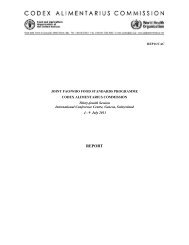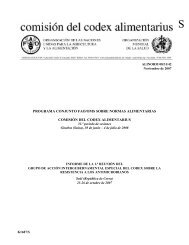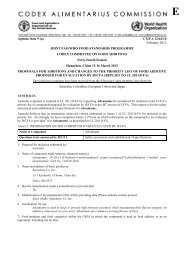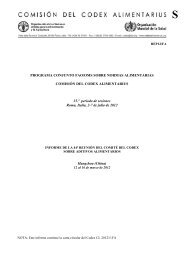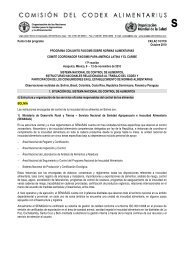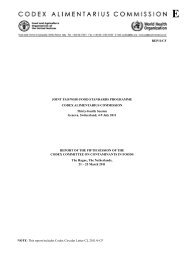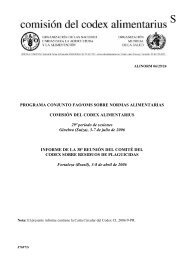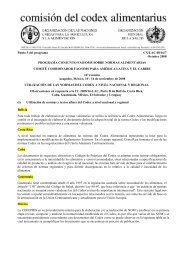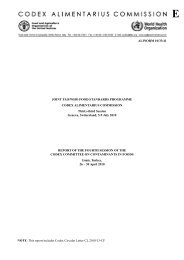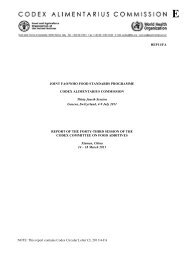REP 12/NFSDU Appendix IV 45APPENDIX IVGUIDELINES ON FORMULATED COMPLEMENTARY FOODS FOR OLDERINFANTS AND YOUNG CHILDREN(Step 5 <str<strong>on</strong>g>of</str<strong>on</strong>g> <str<strong>on</strong>g>the</str<strong>on</strong>g> procedure)1. PURPOSETo provide guidance <strong>on</strong> nutriti<strong>on</strong>al <strong>and</strong> technical aspects <str<strong>on</strong>g>of</str<strong>on</strong>g> <str<strong>on</strong>g>the</str<strong>on</strong>g> producti<strong>on</strong> <str<strong>on</strong>g>of</str<strong>on</strong>g> FormulatedComplementary Foods for older infants <strong>and</strong> young children as defined in Secti<strong>on</strong> 3.1, including:i. Formulati<strong>on</strong> <str<strong>on</strong>g>of</str<strong>on</strong>g> such foods, based <strong>on</strong> <str<strong>on</strong>g>the</str<strong>on</strong>g> nutriti<strong>on</strong>al requirements <str<strong>on</strong>g>of</str<strong>on</strong>g> older infants <strong>and</strong> youngchildren;ii. Processing techniques;iii. Hygienic requirements;iv. Provisi<strong>on</strong>s for packaging;v. Provisi<strong>on</strong>s for labelling <strong>and</strong> instructi<strong>on</strong>s for use.2. SCOPEThe provisi<strong>on</strong>s <str<strong>on</strong>g>of</str<strong>on</strong>g> <str<strong>on</strong>g>the</str<strong>on</strong>g>se Guidelines apply to Formulated Complementary Foods for Older Infants <strong>and</strong>Young Children as defined in Secti<strong>on</strong> 3.1 below <strong>and</strong> include but are not limited to porridgesc<strong>on</strong>taining cereals, ready-to-use products <strong>and</strong> food-based home fortificants. Micr<strong>on</strong>utrientsupplements, processed cereal based foods 1 , <strong>and</strong> canned baby foods 2 are not covered by <str<strong>on</strong>g>the</str<strong>on</strong>g>seGuidelines.These Guidelines should be used in accordance with <str<strong>on</strong>g>the</str<strong>on</strong>g> Global Strategy for Infants <strong>and</strong> Young ChildFeeding <strong>and</strong> World Health Assembly Resoluti<strong>on</strong> WHA54.2 (2001).3. DESCRIPTION3.1 Formulated Complementary Foods for Older Infants <strong>and</strong> Young Children means foods thatare suitable for use during <str<strong>on</strong>g>the</str<strong>on</strong>g> complementary feeding period. These foods are specifically formulatedwith appropriate nutriti<strong>on</strong>al quality to provide additi<strong>on</strong>al energy <strong>and</strong> nutrients to complement <str<strong>on</strong>g>the</str<strong>on</strong>g>family foods derived from <str<strong>on</strong>g>the</str<strong>on</strong>g> local diet by providing those nutrients which are ei<str<strong>on</strong>g>the</str<strong>on</strong>g>r lacking or arepresent in insufficient quantities.3.2 Older infants means pers<strong>on</strong>s from <str<strong>on</strong>g>the</str<strong>on</strong>g> age <str<strong>on</strong>g>of</str<strong>on</strong>g> 6 m<strong>on</strong>ths <strong>and</strong> not more than 12 m<strong>on</strong>ths <str<strong>on</strong>g>of</str<strong>on</strong>g> age.3.3 Young children means pers<strong>on</strong>s from <str<strong>on</strong>g>the</str<strong>on</strong>g> age <str<strong>on</strong>g>of</str<strong>on</strong>g> more than 12 m<strong>on</strong>ths up to <str<strong>on</strong>g>the</str<strong>on</strong>g> age <str<strong>on</strong>g>of</str<strong>on</strong>g> threeyears (36 m<strong>on</strong>ths).3.4 Complementary feeding period means <str<strong>on</strong>g>the</str<strong>on</strong>g> period when older infants <strong>and</strong> young childrentransiti<strong>on</strong> from exclusive feeding <str<strong>on</strong>g>of</str<strong>on</strong>g> breastmilk <strong>and</strong>/or breastmilk substitutes to eating <str<strong>on</strong>g>the</str<strong>on</strong>g> family diet 3 .123<str<strong>on</strong>g>Codex</str<strong>on</strong>g> St<strong>and</strong>ard for Processed Cereal-Based Foods for Infants <strong>and</strong> Young Children (CODEX STAN 74-1981, rev. 1-2006)<str<strong>on</strong>g>Codex</str<strong>on</strong>g> St<strong>and</strong>ard for Canned Baby Foods (CODEX STAN 73-1981)According to <str<strong>on</strong>g>the</str<strong>on</strong>g> WHO, 2002, Complementary Feeding, <str<strong>on</strong>g>Report</str<strong>on</strong>g> <str<strong>on</strong>g>of</str<strong>on</strong>g> <str<strong>on</strong>g>the</str<strong>on</strong>g> Global C<strong>on</strong>sultati<strong>on</strong> appropriate complementaryfeedings should start from <str<strong>on</strong>g>the</str<strong>on</strong>g> age <str<strong>on</strong>g>of</str<strong>on</strong>g> six m<strong>on</strong>ths with c<strong>on</strong>tinued breast feeding up to two years or bey<strong>on</strong>d ; refer also toWHO 2003 Guiding Principles for Complementary feeding <str<strong>on</strong>g>of</str<strong>on</strong>g> <str<strong>on</strong>g>the</str<strong>on</strong>g> breastfed child, WHO 2005 Guiding principles forfeeding n<strong>on</strong>-breastfed children 6-24 m<strong>on</strong>ths <str<strong>on</strong>g>of</str<strong>on</strong>g> age.
REP 12/NFSDU Appendix IV 464. SUITABLE RAW MATERIALS AND INGREDIENTS4.1 Basic Raw Materials <strong>and</strong> IngredientsThe following raw materials, most <str<strong>on</strong>g>of</str<strong>on</strong>g> which are locally available, are suitable ingredients for <str<strong>on</strong>g>the</str<strong>on</strong>g>producti<strong>on</strong> <str<strong>on</strong>g>of</str<strong>on</strong>g> Formulated Complementary Foods for older infants <strong>and</strong> young children under <str<strong>on</strong>g>the</str<strong>on</strong>g>specified c<strong>on</strong>diti<strong>on</strong>s given below:4.1.1 Cereals4.1.1.1 All milled cereals suitable for human c<strong>on</strong>sumpti<strong>on</strong> may be used provided that <str<strong>on</strong>g>the</str<strong>on</strong>g>y areprocessed in such a way as to reduce <str<strong>on</strong>g>the</str<strong>on</strong>g> fibre c<strong>on</strong>tent, when necessary, <strong>and</strong> to decrease <strong>and</strong>, ifpossible, to eliminate anti-nutrients such as phytates, tannins or o<str<strong>on</strong>g>the</str<strong>on</strong>g>r phenolic materials, lectins,trypsin, <strong>and</strong> chymotrypsin inhibitors which can lower <str<strong>on</strong>g>the</str<strong>on</strong>g> protein quality <strong>and</strong> digestibility, amino acidbioavailability <strong>and</strong> mineral absorpti<strong>on</strong>. The use <str<strong>on</strong>g>of</str<strong>on</strong>g> appropriate enzymes may be c<strong>on</strong>sidered to decreasefibre <strong>and</strong> anti-nutrients, if needed.4.1.1.2 Besides carbohydrates (mainly c<strong>on</strong>sisting <str<strong>on</strong>g>of</str<strong>on</strong>g> starch) cereals c<strong>on</strong>tain a significant quantity <str<strong>on</strong>g>of</str<strong>on</strong>g>protein (8-12%) but are limiting in <str<strong>on</strong>g>the</str<strong>on</strong>g> amino acid lysine. Combining cereals with legumes <strong>and</strong>/orpulses, which are higher in lysine, can compensate for <str<strong>on</strong>g>the</str<strong>on</strong>g> limiting level in cereals.4.1.2 Legumes <strong>and</strong> Pulses4.1.2.1 Legumes <strong>and</strong> pulses, such as chick peas, lentils, peas, cowpeas, mungo beans, green gram,kidney beans <strong>and</strong> soya, c<strong>on</strong>taining at least 20% protein <strong>on</strong> a dry weight basis.4.1.2.2 On <str<strong>on</strong>g>the</str<strong>on</strong>g> whole, legumes <strong>and</strong> pulses are deficient in L-methi<strong>on</strong>ine. Depending <strong>on</strong> <str<strong>on</strong>g>the</str<strong>on</strong>g> nature <str<strong>on</strong>g>of</str<strong>on</strong>g><str<strong>on</strong>g>the</str<strong>on</strong>g> o<str<strong>on</strong>g>the</str<strong>on</strong>g>r ingredients in <str<strong>on</strong>g>the</str<strong>on</strong>g> formulati<strong>on</strong>, <str<strong>on</strong>g>the</str<strong>on</strong>g> additi<strong>on</strong> <str<strong>on</strong>g>of</str<strong>on</strong>g> L-methi<strong>on</strong>ine may be desirable in order toimprove <str<strong>on</strong>g>the</str<strong>on</strong>g> nutriti<strong>on</strong>al value <str<strong>on</strong>g>of</str<strong>on</strong>g> <str<strong>on</strong>g>the</str<strong>on</strong>g> product.4.1.2.3 Legumes <strong>and</strong> pulses must be appropriately processed to reduce, as much as possible, <str<strong>on</strong>g>the</str<strong>on</strong>g> antinutriti<strong>on</strong>alfactors normally present, such as phytates, lectins (haemagglutenins), trypsin <strong>and</strong>chymotrypsin inhibitors. When phytoestrogen c<strong>on</strong>taining legumes <strong>and</strong> pulses such as soya are addedas an ingredient, products with low levels <str<strong>on</strong>g>of</str<strong>on</strong>g> phytoestrogens should be used.Lectins can be reduced by moist heat treatment; Trypsin inhibitor activity may be reduced to acceptable levels by heating to high temperaturesor by prol<strong>on</strong>ged boiling.Phytate can be reduced enzymatically or by soaking or fermentati<strong>on</strong>. Phytoestrogens can be reduced by fermentati<strong>on</strong>.4.1.2.4 Field beans or faba beans (Viciafaba L.) should not be used in <str<strong>on</strong>g>the</str<strong>on</strong>g> formulati<strong>on</strong> <str<strong>on</strong>g>of</str<strong>on</strong>g>complementary food for older infants <strong>and</strong> young children because <str<strong>on</strong>g>of</str<strong>on</strong>g> <str<strong>on</strong>g>the</str<strong>on</strong>g> danger <str<strong>on</strong>g>of</str<strong>on</strong>g> favism. Heattreatment does not completely inactivate <str<strong>on</strong>g>the</str<strong>on</strong>g> toxic comp<strong>on</strong>ents (vicine <strong>and</strong> co-vicine).4.1.3 Oil Seed Flours <strong>and</strong> Oil Seed Protein Products4.1.3.1 Flours, protein c<strong>on</strong>centrates <strong>and</strong> protein isolates <str<strong>on</strong>g>of</str<strong>on</strong>g> oil seeds are acceptable if manufactured toappropriate specificati<strong>on</strong>s 4567 which assure sufficient reducti<strong>on</strong> <str<strong>on</strong>g>of</str<strong>on</strong>g> anti-nutriti<strong>on</strong>al factors <strong>and</strong>undesirable toxic substances such as trypsin <strong>and</strong> chymotrypsin inhibitors <strong>and</strong> gossypol. Such seedsmay include4567The following Guidelines were elaborated by <str<strong>on</strong>g>the</str<strong>on</strong>g> FAO/WHO/UNICEF Protein <strong>and</strong> Energy Advisory Group:PAG Guidelines No 2: Preparati<strong>on</strong> <str<strong>on</strong>g>of</str<strong>on</strong>g> Food Quality Ground FlourPAG Guidelines No 4: Preparati<strong>on</strong> <str<strong>on</strong>g>of</str<strong>on</strong>g> Edible Cott<strong>on</strong> Seed Protein C<strong>on</strong>centratesPAG Guidelines No 5: Guideline for Heat Processed Soy Grits <strong>and</strong> Flours<str<strong>on</strong>g>Codex</str<strong>on</strong>g> st<strong>and</strong>ard for Vegetable Protein Products (<str<strong>on</strong>g>Codex</str<strong>on</strong>g> STAN 174-1989)<str<strong>on</strong>g>Codex</str<strong>on</strong>g> st<strong>and</strong>ard for Soy Protein Products (<str<strong>on</strong>g>Codex</str<strong>on</strong>g> STAN 175-1989)<str<strong>on</strong>g>Codex</str<strong>on</strong>g> st<strong>and</strong>ard for Wheat Protein (<str<strong>on</strong>g>Codex</str<strong>on</strong>g> STAN 163-1987)



